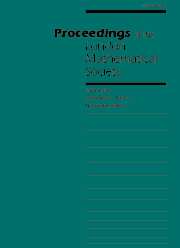Motivic Cohomology of Pairs of Simplices
Published online by Cambridge University Press: 08 March 2004
Abstract
For an arbitrary field $F$ we study the double scissors congruence groups $A_n(F)$ generated by admissible pairs of simplices in the projective $n$-space ${\mathbb P}_F^n$ over $F$. Let $(L, M)$ be an admissible pair of simplices whose faces are defined as hyperplanes in ${\mathbb P}_F^n$ such that they do not have common faces of the same dimension. When $L$ and $M$ are in general positions we define a linearly constructible motivic perverse sheaf producing a motivic cohomology whose Betti realization is the relative cohomology $H^{\ast}({\mathbb P}_F^n\setminus L, M\setminus L; {\mathbb Q})$. The motivic cohomology provides a simple explanation of why the generic part of $A_\bullet$ forms a Hopf algebra with well-defined coproduct. When $n = 2$ we define explicitly the coproduct on $A_2$ which simplifies the approach of Beilinson et al. We also complete the same task for $A_3$ and $A_4$ which enables us to develop further results in another paper connecting Aomoto trilogarithms to the classical ones.
Keywords
- Type
- Research Article
- Information
- Copyright
- 2004 London Mathematical Society
Footnotes
- 2
- Cited by


